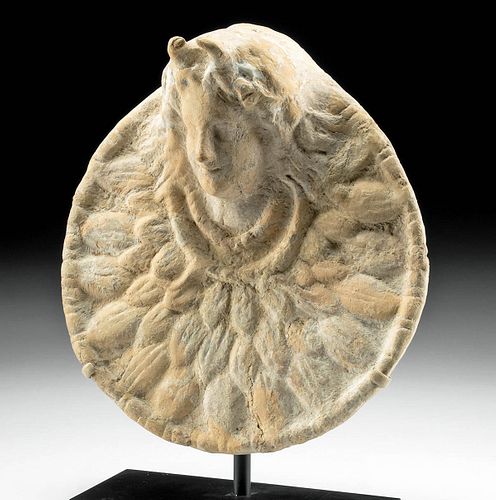Published Greek Terracotta Roundel of Satyr - TL Tested
Lot 22c
About Seller
Artemis Gallery
686 S Taylor Ave, Ste 106
Louisville, CO 80027
United States
Selling antiquities, ancient and ethnographic art online since 1993, Artemis Gallery specializes in Classical Antiquities (Egyptian, Greek, Roman, Near Eastern), Asian, Pre-Columbian, African / Tribal / Oceanographic art. Our extensive inventory includes pottery, stone, metal, wood, glass and textil...Read more
Categories
Estimate:
$3,000 - $4,000
Absentee vs Live bid
Two ways to bid:
- Leave a max absentee bid and the platform will bid on your behalf up to your maximum bid during the live auction.
- Bid live during the auction and your bids will be submitted real-time to the auctioneer.
Bid Increments
| Price | Bid Increment |
|---|---|
| $0 | $25 |
| $300 | $50 |
| $1,000 | $100 |
| $2,000 | $250 |
| $5,000 | $500 |
| $10,000 | $1,000 |
| $20,000 | $2,500 |
| $50,000 | $5,000 |
| $100,000 | $10,000 |
| $200,000 | $20,000 |
About Auction
By Artemis Gallery
Dec 2, 2021
Set Reminder
2021-12-02 10:00:00
2021-12-02 10:00:00
America/New_York
Bidsquare
Bidsquare : Fine Antiquities | Asian | Ethnographic Art
https://www.bidsquare.com/auctions/artemis-gallery/fine-antiquities-asian-ethnographic-art-7918
Features classical antiquities, ancient and ethnographic art from cultures encompassing the globe. Egyptian, Greek, Roman, Etruscan, Near Eastern, Asian, Pre-Columbian, Native American, African / Tribal, Oceanic, Spanish Colonial, Russian, Fine / Visual Arts, so much more! Artemis Gallery info@artemisgallery.com
Features classical antiquities, ancient and ethnographic art from cultures encompassing the globe. Egyptian, Greek, Roman, Etruscan, Near Eastern, Asian, Pre-Columbian, Native American, African / Tribal, Oceanic, Spanish Colonial, Russian, Fine / Visual Arts, so much more! Artemis Gallery info@artemisgallery.com
- Lot Description
Greece, late Hellenistic period, ca. 1st century BCE. An impressive, mold-made terracotta roundel, presenting with a raised rim, a projecting head of a satyr, and nice remains of white pigment. Rendered with remarkable realism, the youthful figure slightly turns to his right and gazes forward, boasting a naturalistic countenance of recessed eyes beneath arched brows, a pointed nose, and closed lips held in a gentle smile. This classical visage is framed by a thick coiffure with cascading locks and capped by a short pair of curved horns that protrude from just above his forehead. A torq or collar surrounds the god's neck, while the rest of the roundel presents a relief of radiating scales or plumes. The raised border is further adorned by incised striations that nicely frame the ancient bust. A pair of perforations are featured at the top of the head, allowing the roundel to be suspended. Size: 8.3" W x 9.2" H (21.1 cm x 23.4 cm); 10.3" H (26.2 cm) on included custom stand.
Hellenistic figural busts like this example are inspired by the many regal portraits of Alexander the Great, though such meticulous stylization could be applied to both male and female subjects. Terracotta roundels, like this example, served as oscilla - votive offerings designed to sway in the wind - and were in widespread production in southern Italy during the Hellenistic period.
In earlier Greek art, satyrs appear as grotesque, old, and ugly; however, in later art, especially in Attic works, these characteristics were softened to present a more youthful and graceful aspect, as we see here. We witness this humanization or transformation of the Satyr in late Greek art. The depiction on this example may be modeled upon this humanized depiction. Another example of this shift occurs in the portrayal of Medusa and in that of the Amazon, characters who are traditionally depicted as barbaric and uncivilized. A humanized Satyr is also depicted in a work of Praxiteles known as the "Resting Satyr."
Published in "Our Collective Past: A Selection of Objects from Antiquity." Fortuna Fine Arts, Ltd., New York, 2006, fig. 8.
This piece has been tested using thermoluminescence (TL) analysis and has been found to be ancient and of the period stated. A full printed and bound report is available for $50 to the buyer. Please contact us to request.
This piece has been searched against the Art Loss Register database and has been cleared. The Art Loss Register maintains the world's largest database of stolen art, collectibles, and antiques.
Provenance: East Coast collection, New York Gallery, New York City, New York, USA, acquired before 2010; ex-private United States collection
All items legal to buy/sell under U.S. Statute covering cultural patrimony Code 2600, CHAPTER 14, and are guaranteed to be as described or your money back.
A Certificate of Authenticity will accompany all winning bids.
PLEASE NOTE: Due to recent increases of shipments being seized by Australian & German customs (even for items with pre-UNESCO provenance), we will no longer ship most antiquities and ancient Chinese art to Australia & Germany. For categories of items that are acceptable to ship to Australia or Germany, please contact us directly or work with your local customs brokerage firm.
Display stands not described as included/custom in the item description are for photography purposes only and will not be included with the item upon shipping.
#167508Repaired from multiple large pieces, with restoration and resurfacing along break lines. Expected nicks, abrasions, and softening of detail, commensurate with age. Otherwise, excellent with nice remaining pigments. TL hole to lower area of verso.Condition
- Shipping Info
-
All shipping is handled in-house for your convenience. Your invoice from Artemis Gallery will include shipping calculation instructions. If in doubt, please inquire BEFORE bidding for estimated shipping costs for individual items.
-
- Buyer's Premium



 EUR
EUR CAD
CAD AUD
AUD GBP
GBP MXN
MXN HKD
HKD CNY
CNY MYR
MYR SEK
SEK SGD
SGD CHF
CHF THB
THB














